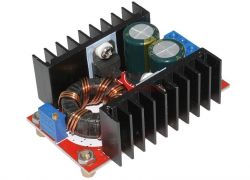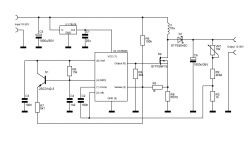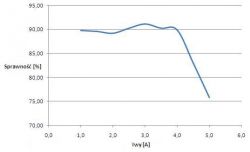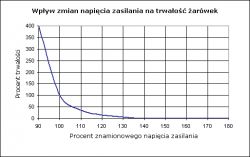Hello.
Below I present to you a short description of the 150W inverter increasing the voltage - step-up configuration.

Inverter data:
- input voltage: 10-32VDC;
- output voltage adjustable in the range: 12-35VDC;
- efficiency: 6A (sometimes you can even find 10A in the sellers' descriptions);
- power: 150W;
- current at rest: 25mA;
- efficiency stated by sellers: approx. 94%;
- dimensions: 65x48x29mm.


You need to spend about $ 2.5 for the purchase of such a converter when buying with a shipment, e.g. from Aliexpress, or about PLN 19 when buying with a shipment on Polish auction portals.
The converter is sold with screwed mounting pins, which is very helpful when mounting it in the target system.
The heart of our tested converter is the UC3843A converter controller. It is powered from the 78L09 voltage stabilizer, so the minimum input voltage of this converter is about 10VDC.
The board also features a choke, a Schottky rectifier diode, a MOSFET transistor, two 1000uF capacitors, a 0.01? resistor used here to measure the current, a potentiometer to adjust the output voltage and a few other small elements.
Diagram of the converter below.

The converter is connected to the power source with cables, by screwing them to the 4-pin KF screw connector, and the output wires to the same connector.
A multi-turn potentiometer is used to regulate the output voltage.
I do not know about other versions of this converter, but in mine there is a 35V capacitor at the output, and the maximum voltage on the converter is also 35V, so it would be appropriate to replace this capacitor if someone intends to use the maximum output voltage.
It's time to start testing.
I powered the converter from a car battery so as not to have problems with power efficiency here.
At the beginning, the measurement of the current consumption in the idle state - it came out about 23mA, so it is within the values declared by the manufacturer.
I set the output voltage to 24VDC.
Below is a table with measurements.

Below is a graph of efficiency to output current.

As you can see - here we managed to achieve an efficiency of about 90%, but above 4A (90W) at the output it drops quite drastically.
The temperature of the converter here reached approx. 115 ° C, so you have to be careful not to burn yourself and it is best to provide the converter with a fan. I did not check what temperature the converter could reach. Each measurement here was approx. 40 seconds. I do not know if the converter would survive a longer 120W draw - I did not test it.
After this test, I did one more, where I set the output voltage to the maximum to see how the output voltage behaves. In my case, this voltage was 33.5V.
This voltage was maintained up to about 2.8A, and at about 5A the voltage was less than 21V.
With this test, I did not measure the current consumption from the battery anymore.
During the tests, the converter did not make any squeaks, hums or hums, you can say that you cannot hear its operation.
The inverter was bought for a friend with the intention of using it as a power supply for a laptop in the car and to this day it works. I did not have the opportunity to measure the temperature or the power consumed there, but the converters with this application can be safely held in the hand without fear of burns. It has been in its possession for several months and has not caused any problems to date. It is used up to several hours a week.
Note that this is a step-up converter, so it is not suitable for powering laptops in "TIRs", where there is 24VDC in the cigarette lighter socket.
It should be remembered that this converter has no protections - i.e. there is no protection against reverse power connection, overload and too high temperature.
If you want to take more power from it, you should equip it with a fan and you can also think about replacing the heat sinks, because these, as you can see, have something to do with higher powers.
In the descriptions of the sellers you can find information that this inverter can give 100W maximum with natural cooling and a maximum of 150W with forced cooling.
We can also find information that if the ambient temperature is higher than 40 ° C, the converter cooling should be increased.
I have not examined this converter with an oscilloscope, so I will not comment on its "sowing" noise.
Below I present to you a short description of the 150W inverter increasing the voltage - step-up configuration.

Inverter data:
- input voltage: 10-32VDC;
- output voltage adjustable in the range: 12-35VDC;
- efficiency: 6A (sometimes you can even find 10A in the sellers' descriptions);
- power: 150W;
- current at rest: 25mA;
- efficiency stated by sellers: approx. 94%;
- dimensions: 65x48x29mm.


You need to spend about $ 2.5 for the purchase of such a converter when buying with a shipment, e.g. from Aliexpress, or about PLN 19 when buying with a shipment on Polish auction portals.
The converter is sold with screwed mounting pins, which is very helpful when mounting it in the target system.
The heart of our tested converter is the UC3843A converter controller. It is powered from the 78L09 voltage stabilizer, so the minimum input voltage of this converter is about 10VDC.
The board also features a choke, a Schottky rectifier diode, a MOSFET transistor, two 1000uF capacitors, a 0.01? resistor used here to measure the current, a potentiometer to adjust the output voltage and a few other small elements.
Diagram of the converter below.

The converter is connected to the power source with cables, by screwing them to the 4-pin KF screw connector, and the output wires to the same connector.
A multi-turn potentiometer is used to regulate the output voltage.
I do not know about other versions of this converter, but in mine there is a 35V capacitor at the output, and the maximum voltage on the converter is also 35V, so it would be appropriate to replace this capacitor if someone intends to use the maximum output voltage.
It's time to start testing.
I powered the converter from a car battery so as not to have problems with power efficiency here.
At the beginning, the measurement of the current consumption in the idle state - it came out about 23mA, so it is within the values declared by the manufacturer.
I set the output voltage to 24VDC.
Below is a table with measurements.

Below is a graph of efficiency to output current.

As you can see - here we managed to achieve an efficiency of about 90%, but above 4A (90W) at the output it drops quite drastically.
The temperature of the converter here reached approx. 115 ° C, so you have to be careful not to burn yourself and it is best to provide the converter with a fan. I did not check what temperature the converter could reach. Each measurement here was approx. 40 seconds. I do not know if the converter would survive a longer 120W draw - I did not test it.
After this test, I did one more, where I set the output voltage to the maximum to see how the output voltage behaves. In my case, this voltage was 33.5V.
This voltage was maintained up to about 2.8A, and at about 5A the voltage was less than 21V.
With this test, I did not measure the current consumption from the battery anymore.
During the tests, the converter did not make any squeaks, hums or hums, you can say that you cannot hear its operation.
The inverter was bought for a friend with the intention of using it as a power supply for a laptop in the car and to this day it works. I did not have the opportunity to measure the temperature or the power consumed there, but the converters with this application can be safely held in the hand without fear of burns. It has been in its possession for several months and has not caused any problems to date. It is used up to several hours a week.
Note that this is a step-up converter, so it is not suitable for powering laptops in "TIRs", where there is 24VDC in the cigarette lighter socket.
It should be remembered that this converter has no protections - i.e. there is no protection against reverse power connection, overload and too high temperature.
If you want to take more power from it, you should equip it with a fan and you can also think about replacing the heat sinks, because these, as you can see, have something to do with higher powers.
In the descriptions of the sellers you can find information that this inverter can give 100W maximum with natural cooling and a maximum of 150W with forced cooling.
We can also find information that if the ambient temperature is higher than 40 ° C, the converter cooling should be increased.
I have not examined this converter with an oscilloscope, so I will not comment on its "sowing" noise.
Cool? Ranking DIY








 [3]
[3]